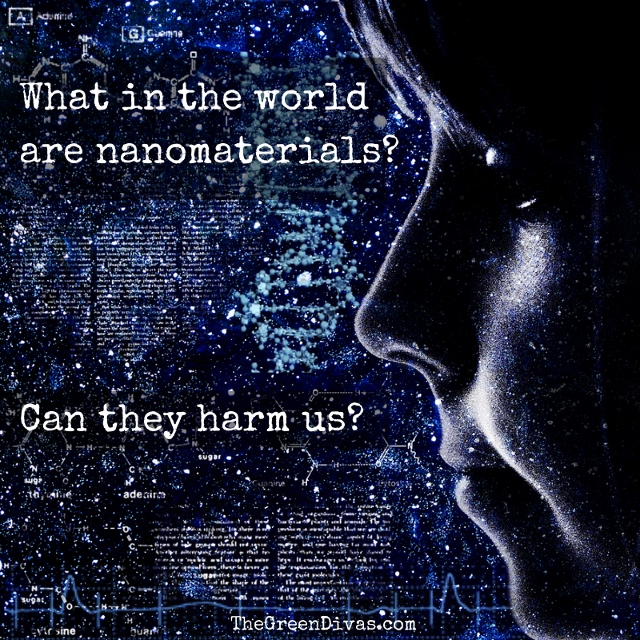What in the world are nanomaterials?
Listen to the recent Green Divas Radio Show featuring Jennifer Sass, PhD (Sr. Scientist, Natural Resources Defense Council. She explains nanotechnology in our everyday world and why we should be concerned. Then read on for what she wrote about nanomaterials… and how they may harm us.
What is nanotechnology?
Nanotechnology is the understanding and control of matter at dimensions between approximately 1 and 100 nanometers (nm), where unique phenomena enable novel applications. It encompasses nanoscale science, engineering and technology. Nanotechnology involves imaging, measuring, modeling and manipulating matter at this length scale.
Are we exposed to nanomaterials?
Nanotechnologies are predicted to reshape the world from the atom up. There are over 1600 consumer products using nanotechnologies, according to manufacturer claims. Every sector and every Fortune 500 company is invested in nanotechnology, including cosmetics, clothing, sporting equipment, food packaging and children’s products.
Here are 4 ways nanomaterials may harm us:
1. The concern is that unique properties at small scale may impart unique toxicity, so something that is not harmful at normal scale may be harmful at nano-scale.
2. Small size facilitates easier access to the lungs, passage through cell membranes, and possibly skin penetration.
3. Once inside the body, nanomaterials seem to have access to all tissues and organs, including the brain and fetal circulation.
4. Inhaled, nanomaterials have the potential to pass directly from the lungs into the blood stream and from there to all organs including the brain and fetal circulation. Exposure to nano-sized chemicals is concerning since we know that nano-size air pollution increases risk of lung cancer, heart and lung disease, and death.
A report of the NATO Parliamentary Assembly* stated:
“The potential for NT innovations in chemical and biological weapons is particularly disquieting, as NT can considerably enhance the delivery mechanisms of agents or toxic substances. The ability of nanoparticles to penetrate the human body and its cells could make biological and chemical warfare much more feasible, easier to manage and to direct against specific groups or individuals.”
There must be regulations and government oversight to protect people and the environment from harmful exposures to nanomaterials… right?
Unfortunately, chemicals are generally poorly regulated and new chemicals including nanomaterials fall through the regulatory loopholes. One problem is that new chemicals can be approved for market without any toxicity testing. The burden is on the government to prove harm, instead of the chemical manufacturer to prove safety. And, no data is treated as if it meant no risk. Another problem is that there is often no easy or portable detection equipment for finding nanomaterials in air, water, or soil…and that means the government has little ability to enforce environmental protection laws.
What can we do?
We need laws to ensure that new chemicals, including nanomaterials, are tested for toxicity before they’re allowed onto the market. And, there should be public disclosure of the toxicity testing results. Click here to find products containing nanomaterials.
* NATO Parliamentary Assembly Committee (2005) 179 STCMT 05 E – The Security Implications of Nanotechnology
Edited by Lynn Hasselberger
 Jennifer Sass, PhD, is a Senior Scientist for Natural Resources Defense Council (NRDC). You can read more of her work on the NRDC Switchboard Blog. Connect with Jennifer on twitter @JBSass.
Jennifer Sass, PhD, is a Senior Scientist for Natural Resources Defense Council (NRDC). You can read more of her work on the NRDC Switchboard Blog. Connect with Jennifer on twitter @JBSass.
NRDC is the nation’s most effective environmental action group, combining the grassroots power of 1.4 million members and online activists with the courtroom clout and expertise of more than 350 lawyers, scientists and other professionals. Take action with NRDC here.
On Google+?
CLICK HERE to add the GDs to your circles!
CLICK HERE to join the GDs G+ community!

Pingback: 4 Reasons Nanomaterials May Be Bad for Us. | Care2 Healthy Living